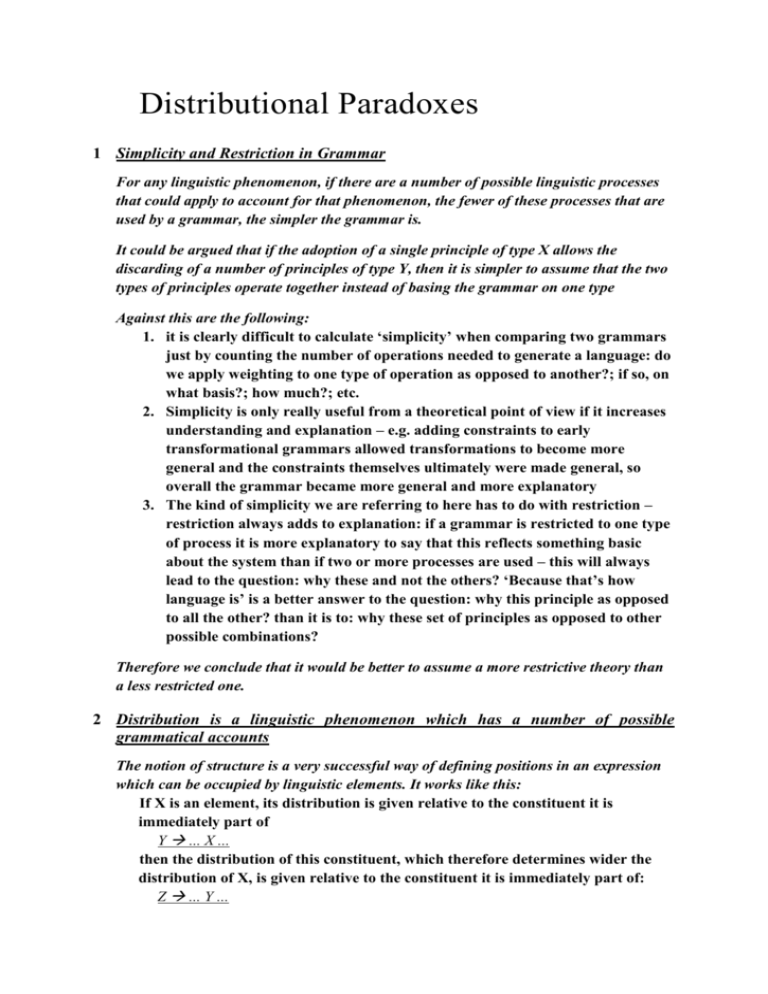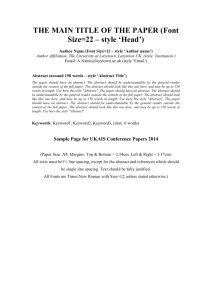04a Distributional Paradoxes
advertisement

Distributional Paradoxes
1 Simplicity and Restriction in Grammar
For any linguistic phenomenon, if there are a number of possible linguistic processes
that could apply to account for that phenomenon, the fewer of these processes that are
used by a grammar, the simpler the grammar is.
It could be argued that if the adoption of a single principle of type X allows the
discarding of a number of principles of type Y, then it is simpler to assume that the two
types of principles operate together instead of basing the grammar on one type
Against this are the following:
1. it is clearly difficult to calculate ‘simplicity’ when comparing two grammars
just by counting the number of operations needed to generate a language: do
we apply weighting to one type of operation as opposed to another?; if so, on
what basis?; how much?; etc.
2. Simplicity is only really useful from a theoretical point of view if it increases
understanding and explanation – e.g. adding constraints to early
transformational grammars allowed transformations to become more
general and the constraints themselves ultimately were made general, so
overall the grammar became more general and more explanatory
3. The kind of simplicity we are referring to here has to do with restriction –
restriction always adds to explanation: if a grammar is restricted to one type
of process it is more explanatory to say that this reflects something basic
about the system than if two or more processes are used – this will always
lead to the question: why these and not the others? ‘Because that’s how
language is’ is a better answer to the question: why this principle as opposed
to all the other? than it is to: why these set of principles as opposed to other
possible combinations?
Therefore we conclude that it would be better to assume a more restrictive theory than
a less restricted one.
2 Distribution is a linguistic phenomenon which has a number of possible
grammatical accounts
The notion of structure is a very successful way of defining positions in an expression
which can be occupied by linguistic elements. It works like this:
If X is an element, its distribution is given relative to the constituent it is
immediately part of
Y ... X ...
then the distribution of this constituent, which therefore determines wider the
distribution of X, is given relative to the constituent it is immediately part of:
Z ... Y ...
and so forth until the root is reached
In other words:
If X has distribution, this is given with respect to the root or with respect to Y
which has distribution
What ‘given with respect to X’ means is ‘placed in a position relative to the other
immediate constituents of X’
It is also possible to give a linear account of distribution:
If X is an element, its distribution is given relative to Y that it is dependent on
X precedes Y, X follows Y
then the distribution of Y, which therefore determines the wider distribution of
X, is given relative to Z which it is dependent on
Y precedes Z, Y follows Z
and so forth until the root (element) is reached
In other words:
if X has distribution, this is given with respect to the root or with respect to Y
which has distribution
What ‘given with respect to X’ means is placed in a position relative to X
It should be noted that the linear approach may involve conflict
if the linear relations are not just simply X preceded or follows Y at any distance
(it would be difficult to see how this could provide an account of distribution)
then we are bound to get conflicts such as X precedes Y and Z precedes Y or X
precedes Y and Y follows Z
The structural account avoids such conflict by placing limitation on the elements that
any particular element is ordered with respect to (X will only precede or follow the
elements which are its co-immediate constituents within a constituent).
3 Given this, we can ask is it possible to give an account of distribution in purely
structural terms?
4 To determine this we need to recognise certain properties of structurally
determined distribution
It follows from the lack of conflicting requirements in the structure approach that its
conditions are absolute
Thus we can say that X and Y will be in complementary distribution if they conform to
the same distributional requirements
Note that this is not so in a system which allows conflict as if X and Y have the
same distributional requirements (and hence are in conflict with each other) then
they are not necessarily in complementary distribution depending on how the
conflict is resolved
It also follows that if X has the same distributional requirements as Y and Y has the
same distributional requirements as Z, then X and Z will be in complementary
distribution as the relationship ‘has the same distributional requirements’ (= is the
same category as) is transitive
Again, this is not necessarily so if conflict is allowed: if X, Y and Z all have the
same distributional requirements, it follows that the interaction between them
will be more complex, but not that the appearance of one will restrict the
appearance of any of the others.
Another consequence of the structural approach to distribution is that if two elements
are in complementary distribution with each other in one place, then they should be in
complementary distribution with each other in all places
This is because if distribution is defined in terms of structure alone, then there
can be no other explanation for why two elements are in complementary
distribution than that they have the same distributional requirements
5 Here are some paradoxical distributions which cannot be given a purely
structural account
1. Wh phrases are in complementary distribution with complementisers
2. complementisers are in complementary distribution with inverted auxiliaries
3. wh phrases are not in complementary distribution with inverted auxiliaries
If structure were the only determining fact for distribution then this situation cannot
arise.
Obviously some other explanation is called in to account for this:
Wh-phrases and complementisers cannot co-occur not because they occupy the
same structural position, but because “the specifier of CP and the head of C
cannot be filled simultaneously by overt elements” (Doubly filled COMP filter).
This looks suspiciously like a linear restriction, not a structural one.
Determiners and Possessors are in complementary distribution
𝐷𝑒𝑡
𝑁𝑃 → {
}𝑁
𝑁𝑃′𝑠
This rule introduces something more than structure to account for the
observation: the curly brackets is not something that can be rendered in purely
structural terms. Note, it isn’t the same as:
𝑁𝑃 → 𝐷𝑒𝑡 𝑁
𝑁𝑃 → 𝐷𝑃′ 𝑠 𝑁
Because these say that a determiner and a possessor are in front of a noun in an
NP, but not that they occupy the same structural position. For this you would
need something like:
𝑁𝑃 → 𝑆𝑝𝑒𝑐 𝑁
𝑆𝑝𝑒𝑐 → 𝐷𝑒𝑡
𝑆𝑝𝑒𝑐 → 𝑁𝑃′𝑠
But this then classifies determiners and possessive NPs as the same thing
1. Hungarian negative is in complementary distribution with the pre-verb
2. pre-verb is in complementary distribution with foci
3. foci are not in complementary distribution with the negative
1. Hungarian pre-verbal foci are in complementary distribution with fronted
Negative phrases
2. pre-verbal foci are in complementary distribution with each other
3. fronted negative phrases are not in complementary distribution with each other








